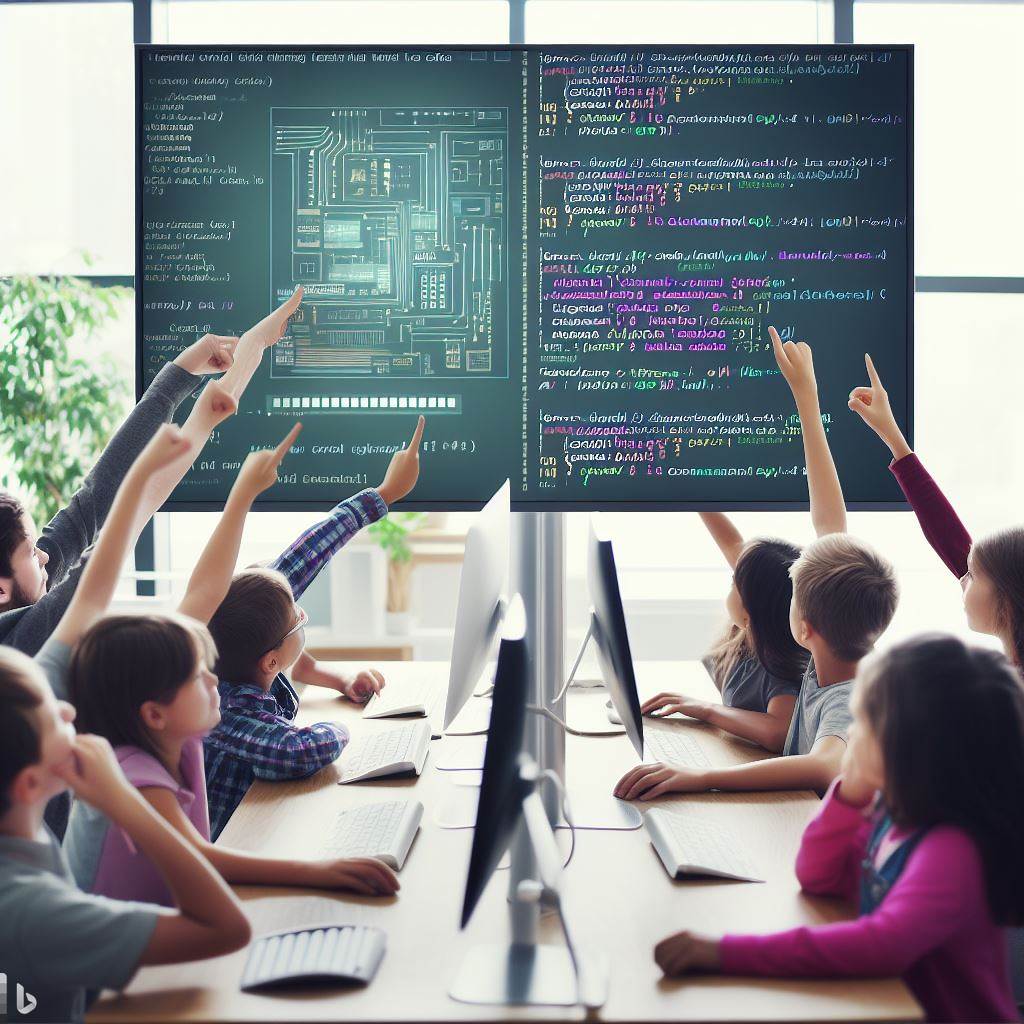Introduction
CodeHS is a popular coding learning platform that offers a comprehensive curriculum for students of all levels.
It provides interactive lessons, coding exercises, and projects to help learners develop their coding skills.
Brief Explanation of CodeHS and Its Popularity as a Coding Learning Platform
CodeHS has gained popularity among educators and students due to its user-friendly interface, engaging content, and effective teaching methodologies.
With its structured curriculum, CodeHS ensures that learners progress systematically from basics to advanced coding concepts.
It provides a hands-on learning experience, allowing students to practice coding in real-time.
Importance of Addressing Common Pitfalls for a Smooth Learning Experience
While using CodeHS, it is crucial to address common pitfalls that learners may encounter. By identifying and overcoming these challenges, students can have a more seamless and productive learning experience.
Common pitfalls can include difficulties understanding complex coding concepts, struggling to debug errors, or feeling overwhelmed by coding exercises.
Addressing these pitfalls helps learners develop a better understanding of coding principles, enhance problem-solving skills, and build confidence in their abilities.
It allows them to overcome obstacles and progress effectively through the curriculum. By recognizing common pitfalls and providing guidance and support, CodeHS enables learners to grow as proficient coders.
CodeHS has emerged as an effective platform for learning coding skills, offering a structured curriculum that caters to students of all levels.
By addressing and navigating common pitfalls, learners can maximize their learning experience and develop a solid foundation in coding.
With the guidance and support provided by CodeHS, students can overcome challenges and become successful coders.
Common Pitfall 1: Lack of Understanding the Basics
Before progressing further, it is crucial to grasp the fundamentals for success in CodeHS.
- Start by familiarizing yourself with the syntax and basic concepts of the programming language.
- Utilize CodeHS’s resources such as documentation, tutorials, and example codes to deepen your understanding.
- Practice regularly by working on coding exercises and projects to solidify your comprehension.
- If you encounter difficulties or confusion, don’t hesitate to seek clarifications from CodeHS’s support system.
- Consider joining online communities and forums where you can discuss concepts, ask questions, and learn from others.
Remember, a strong foundation in the basics will pave the way for your success in CodeHS!
Read: Getting Started with C# by Writing ‘Hello World’
Tech Consulting Tailored to Your Coding Journey
Get expert guidance in coding with a personalized consultation. Receive unique, actionable insights delivered in 1-3 business days.
Get StartedCommon Pitfall 2: Wrong Approach to Problem-solving
One common pitfall in coding is the tendency to rush through problems without proper analysis.
Many students, especially beginners, often jump straight into writing code without fully understanding the problem at hand.
This hasty approach can lead to errors, inefficiencies, and frustration. It is crucial to take the time to analyze the problem and devise an effective plan before starting to code.
The significance of breaking down problems and planning ahead
Breaking down complex problems into smaller, manageable sub-problems is essential in problem-solving.
It allows for a better understanding of the problem and enables an incremental approach, making it easier to tackle each component individually.
By planning ahead, developers can envision the solution and identify potential challenges or roadblocks early on. This helps in allocating resources efficiently and streamlining the coding process.
Strategies for effective problem-solving
- Pseudocode: One effective strategy is to use pseudocode, which is a simplified form of writing code in plain language. Pseudocode helps to outline the logical steps required to solve a problem and facilitates the thought process.
By writing pseudocode, developers can focus on the high-level logic without worrying about specific syntax or implementation details. - Problem decomposition: Another useful technique is problem decomposition. It involves breaking down a complex problem into smaller, more manageable parts. Each part can then be solved individually, making the overall task less daunting.
By decomposing a problem, developers can identify patterns and similarities between different parts. - Test-driven development (TDD): Test-driven development (TDD) is a methodology that involves writing tests before writing the actual code. It helps in better understanding the problem requirements and ensures that the code meets those requirements.
By following TDD, developers can focus on solving specific problems, as each test case represents a specific requirement or functionality. It also improves the overall code quality and reduces the likelihood of introducing bugs or errors. - Collaborate and seek guidance: Problem-solving is not always a solitary task. Collaborating with peers, seeking guidance from mentors, or participating in online coding communities can provide valuable insights and alternative perspectives.
Interacting with others can help in identifying different approaches, spotting potential improvements, and learning from their experiences. It also fosters a sense of community and helps in overcoming obstacles more effectively.
Avoiding the wrong approach to problem-solving is imperative to become a proficient coder. Rushing through problems without proper analysis can hinder progress and lead to suboptimal solutions.
By breaking down problems, planning ahead, utilizing strategies like pseudocode and problem decomposition, practicing test-driven development, and seeking collaboration, coders can enhance their problem-solving skills and produce high-quality code.
Remember, taking the time to understand the problem and design a thoughtful solution saves time and effort in the long run.
Read: Swift ‘Hello World’: Building Your First iOS App
Common Pitfall 3: Overlooking Documentation and Resources
When it comes to learning programming on CodeHS, students often encounter various challenges along the way.
In this blog section, we will explore one common pitfall that students should avoid: overlooking documentation and resources.
By emphasizing the value of utilizing available resources, suggesting good practices for searching, reading, and understanding documentation, and encouraging active participation in the CodeHS community, students can find the support and guidance they need to excel in programming.
Emphasize the Value of Utilizing Available Resources
One of the biggest mistakes that students make is not fully utilizing the documentation and resources provided by CodeHS.
Build Your Vision, Perfectly Tailored
Get a custom-built website or application that matches your vision and needs. Stand out from the crowd with a solution designed just for you—professional, scalable, and seamless.
Get StartedThese resources are carefully curated to provide helpful explanations, examples, and even answers to common questions.
By overlooking these valuable resources, students limit their potential for learning and growth. Therefore, it is important to stress the significance of these resources and encourage students to make use of them.
Suggest Good Practices for Searching, Reading, and Understanding Documentation
While documentation can be comprehensive, finding the most relevant information can be challenging.
Students should be encouraged to develop effective searching techniques when navigating through the documentation.
They can make use of keywords, specific terms, and even language-specific searches to find the information they need.
Moreover, students should be reminded to read the documentation carefully, paying attention to details, syntax, and examples provided.
Understanding the documentation is crucial in grasping concepts and applying them effectively.
Encourage Active Participation in the CodeHS Community
The CodeHS platform offers a vibrant community of learners, instructors, and experts who are readily available to assist students.
Encouraging students to actively participate in this community can bring immense benefits.
By posting questions, engaging in discussions, and seeking guidance from peers and instructors, students can find the support they need when facing challenges.
This sense of community fosters a collaborative spirit and creates an environment where students can learn from each other.
Furthermore, engaging with other members of the CodeHS community exposes students to a diverse range of perspectives, which can enhance their problem-solving skills and enrich their understanding of programming concepts.
Students can also contribute by sharing their insights and solutions to help others. This reciprocity strengthens the community as a whole and promotes a positive learning experience.
Basically, overlooking documentation and resources is a common pitfall that students should avoid when learning programming on CodeHS.
Optimize Your Profile, Get Noticed
Make your resume and LinkedIn stand out to employers with a profile that highlights your technical skills and project experience. Elevate your career with a polished and professional presence.
Get NoticedBy emphasizing the value of resources, suggesting good practices for navigating documentation, and encouraging active participation in the CodeHS community, students can overcome this pitfall and excel in their programming journey.
Remember, programming is not just about writing code, but also about utilizing available tools and resources to enhance learning and problem-solving skills.
Read: How to Style Forms Effectively Using CSS

Common Pitfall 4: Lack of Persistence and Perseverance
In the world of coding, it is common for students to face various challenges that can often lead to frustration and a lack of motivation.
One of the most significant challenges they may encounter is the lack of persistence and perseverance. This pitfall refers to the tendency of giving up easily when faced with difficulties and obstacles in coding.
It is crucial for students to understand the importance of perseverance in overcoming these challenges and achieving success in their coding journey.
The Challenges of Coding
Coding, like any other skill, requires time, effort, and continuous learning. Students may face challenges in understanding complex concepts, solving intricate problems, and implementing code effectively.
It is common for them to encounter bugs and errors along the way, which can be frustrating and demotivating.
Coding often demands logical thinking and attention to detail, which can be overwhelming for some students.
The Importance of Persistence
Persistence is the key to mastering any skill, including coding. It is essential for students to embrace challenges rather than giving up on them.
When faced with difficulties, it is crucial to have the determination to keep going, explore different approaches, and learn from mistakes.
By persisting through challenges, students develop resilience and adaptability, which are vital skills not only in coding but also in life.
Tips for Staying Motivated and Overcoming Obstacles
While persistence is crucial, it is also essential for students to find ways to stay motivated and overcome obstacles. Here are some tips to help students face coding challenges with confidence:
- Take Breaks: Coding can be mentally exhausting. Taking short breaks allows students to recharge their minds and approach problems with a fresh perspective.
- Set Achievable Goals: Breaking down complex tasks into smaller, achievable goals helps students track their progress and boosts their confidence.
- Seek Help: It is essential for students to remember that seeking help is not a sign of weakness. Asking for assistance from teachers, mentors, or peers can provide valuable insights and solutions to coding problems.
- Record and Analyze Progress: Keeping a record of completed coding projects and reflecting on past obstacles and how they were overcome can serve as a great source of motivation and inspiration.
- Engage in Collaborative Coding: Participating in coding communities or group projects allows students to learn from others, share ideas, and support each other through challenges.
- Celebrate Successes: Celebrating even the smallest achievements in coding helps students stay motivated and builds a positive mindset towards challenges.
By implementing these tips, students can develop a mindset that thrives on persistence and resilience. They will be better equipped to tackle coding challenges head-on and continue to grow and improve as programmers.
Persistence and perseverance are essential qualities that students need to cultivate in their coding journey.
By understanding the challenges they may face, staying motivated, and seeking help when needed, students can overcome obstacles and achieve success in coding.
The ability to persist through challenges not only contributes to their growth as programmers but also prepares them for a future where problem-solving and adaptability are valuable skills in any field.
Read: How to Create Dynamic Web Forms with JavaScript
Common Pitfall 5: Neglecting Debugging and Error Analysis
Debugging and error analysis are critical components of programming, yet many CodeHS users overlook them.
Ignoring error messages and failing to debug code are common mistakes that can lead to frustration and time-consuming troubleshooting.
Common Mistakes in Overlooking Error Messages and Not Debugging Code
- Ignoring error messages: One of the biggest mistakes programmers make is ignoring error messages altogether. They often assume that the code will magically fix itself or that the error is not important.
- Not understanding error messages: Another common pitfall is when programmers fail to comprehend the meaning behind error messages. Instead of carefully reading and trying to understand them, they simply brush them off.
- Skipping the debugging process: Debugging is a crucial step in the coding process. However, some programmers skip this step entirely, assuming that their code is flawless and that no bugs exist. This leads to undetected errors and unexpected behaviors in the program.
Guidance on Effective Debugging Techniques
To avoid these pitfalls and improve your programming experience on CodeHS, it is important to employ effective debugging techniques. Here are some tips:
- Read error messages carefully: When you encounter an error message, don’t ignore it. Read it carefully and try to understand what it is telling you. Often, error messages provide valuable hints about what went wrong in your code.
- Break down complex problems: If you are faced with a complex problem, don’t try to solve it all at once. Break it down into smaller, manageable parts. This will make the debugging process more manageable and help you pinpoint the exact cause of the error.
- Print values: Inserting print statements at strategic points in your code can help you track the values of variables and identify where the error is occurring. By printing relevant values, you can narrow down your search for the bug.
- Step-by-step analysis: Debugging is often a step-by-step process. Go through your code line by line and analyze each step to ensure that it is functioning as expected. This thorough analysis can uncover hidden errors and improve the overall quality of your code.
- Utilize online resources and forums: If you’re stuck and unable to debug your code, don’t hesitate to seek help from online resources and programming forums. Often, others have encountered similar issues and can provide valuable insights to help you overcome the problem.
By adopting these effective debugging techniques, you can significantly reduce the time spent on troubleshooting and create more robust and error-free code.
Conclusion
Being aware of common CodeHS pitfalls is essential for a successful coding journey. By understanding these pitfalls and following the provided tips, learners can avoid unnecessary frustration and ensure a smoother learning process.
The first pitfall discussed was overlooking the importance of reading instructions carefully, resulting in errors and wasted time.
It is crucial to take the time to understand the instructions before starting any coding exercises.
The second pitfall was neglecting to utilize the available resources, such as the CodeHS forum and instructional videos, which can provide valuable insights and guidance.
Another pitfall was the tendency to rush through coding exercises without thoroughly understanding the concepts.
Taking the time to grasp the underlying principles and seeking help when needed ensures a solid foundation for future coding endeavors.
Additionally, learners should be cautious about comparing their progress to others, as this can lead to unnecessary self-doubt and discouragement.
Each individual’s learning pace is unique, and it is vital to focus on personal growth and improvement.
To avoid these pitfalls, readers are encouraged to develop good coding habits such as reading instructions thoroughly, utilizing available resources, and seeking help from peers and instructors when necessary.
It is important to be patient, persistent, and open to learning from mistakes.
By being aware of these common pitfalls and following the provided tips, readers can enhance their learning experience on CodeHS and improve their coding skills effectively. Happy coding!
Learn to Code with LearnCode
- Dive into 250 interactive lectures on LearnCode.
- Begin as a novice and emerge as an expert.
- Craft websites, Android, iOS, and desktop apps.
- Master HTML, CSS, JavaScript, PHP, MySQL, Apache Cordova, Node Webkit, and hosting techniques.
- Each lecture comes with an engaging assignment.
- Pose questions directly on any lecture topic.
- Progress at a speed that suits you.
- Earn a professional certificate upon completion.
- Join an exclusive group to monetize your coding skills.
- Parents and guardians can enroll young learners.
Discover the power of coding. Start your journey at LearnCode.
[E-Books for Sale]
500 Cutting-Edge Tech Startup Ideas for 2024 & 2025: Innovate, Create, Dominate
$19.99 • 500 Tech Startup Ideas • 62 pages
You will get inspired with 500 innovative tech startup ideas for 2024 and 2025, complete with concise descriptions to help you kickstart your entrepreneurial journey in AI, Blockchain, IoT, Fintech, and AR/VR.
See All 500 Tech Startup Ideas of this E-Book
How to Code: A Beginner’s Guide to Mastering Programming
$4.99 • 13 Chapters • 32 pages
Unlock programming skills with 'How to Code: A Beginner's Guide.' Start your journey to mastering coding and build your future today.




